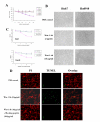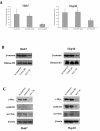Blockade of Wnt-1 signaling leads to anti-tumor effects in hepatocellular carcinoma cells
- PMID: 19778454
- PMCID: PMC2759906
- DOI: 10.1186/1476-4598-8-76
Blockade of Wnt-1 signaling leads to anti-tumor effects in hepatocellular carcinoma cells
Abstract
Background: Hepatocellular carcinoma (HCC) is an aggressive cancer, and is the third leading cause of cancer death worldwide. Standard therapy is ineffective partly because HCC is intrinsically resistant to conventional chemotherapy. Its poor prognosis and limited treatment options make it critical to develop novel and selective chemotherapeutic agents. Since the Wnt/beta-catenin pathway is essential in HCC carcinogenesis, we studied the inhibition of Wnt-1-mediated signaling as a potential molecular target in HCC.
Results: We demonstrated that Wnt-1 is highly expressed in human hepatoma cell lines and a subgroup of human HCC tissues compared to paired adjacent non-tumor tissues. An anti-Wnt-1 antibody dose-dependently decreased viability and proliferation of Huh7 and Hep40 cells over-expressing Wnt-1 and harboring wild type beta-catenin, but did not affect normal hepatocytes with undetectable Wnt-1 expression. Apoptosis was also observed in Huh7 and Hep40 cells after treatment with anti-Wnt-1 antibody. In these two cell lines, the anti-Wnt-1 antibody decreased beta-catenin/Tcf4 transcriptional activities, which were associated with down-regulation of the endogenous beta-catenin/Tcf4 target genes c-Myc, cyclin D1, and survivin. Intratumoral injection of anti-Wnt-1 antibody suppressed in vivo tumor growth in a Huh7 xenograft model, which was also associated with apoptosis and reduced c-Myc, cyclin D1, and survivin expressions.
Conclusion: Our results suggest that Wnt-1 is a survival factor for HCC cells, and that the blockade of Wnt-1-mediated signaling may offer a potential pathway-specific therapeutic strategy for the treatment of a subgroup of HCC that over-expresses Wnt-1.
Figures




References
Publication types
MeSH terms
Substances
LinkOut - more resources
Full Text Sources
Other Literature Sources
Molecular Biology Databases
Research Materials

